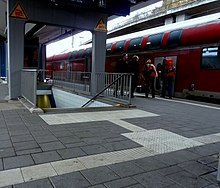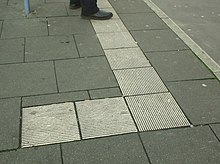Blind guidance system
As the Blind systems (sometimes called guidance system) commonly referred to, which blind and highly visually impaired allow people with the help of a pendulum or long cane to move by themselves safer and easier in the public space, in buildings and on public transportation stops.
As a rule, it is about tactile ground guidance systems , alternative expression tactile ground guidance systems, of ground indicators.
Internationally and regionally differently designed Tactile find ground control systems of both optical and contact contrasting soil indicators such as grooved and dimpled plates or -pflaster as structural features of streets , squares, stops of public transport , railway stations and public institutions with control systems. The aim of the equipment is accessibility in public (street) space.
history
Guidance systems for the blind were developed by the Japanese Seiichi Miyake in 1965 for a friend, after which they became established worldwide.
features
As a rule, guidance systems for the blind consist of guide strips and attention fields. Guide strips provide guidance and orientation to important destinations, such as exits and entrances, stairs, elevators and large areas, e.g. B. Squares, or help to avoid obstacles.

Areas of attention can have very different functions:
- Junction fields indicate branches or changes of direction
- Direction fields show directions, e.g. B. when crossing lanes
- Detection strips indicate the beginning of a guidance system for the blind or to targets at the side, e.g. B. Stops or elevators
- Entry fields mark the entry, e.g. B. at bus stops
- Warning fields warn of obstacles
- Collection strips limit areas that can be walked on, e.g. B. on platforms
Guide strips and attention fields can consist of white or black plates. If there are no tactile or optical contrasts between the guide strips or attention fields, an accompanying strip is created from high-contrast floor elements.
The blind can use the conductive strip and attention fields by means of a blind man's cane grope and be oriented so on. Guidance systems for the blind also include the equipping of banisters or elevators with lettering in Braille or pyramid writing and the high-contrast marking of steps or platform edges. The aim of creating guidance systems for the blind is to provide blind and visually impaired people with continuous chains of paths and to enable them to use the corresponding facilities. The soil indicators are i. d. Usually grooved or ribbed plates and knobbed plates are used, occasionally other surfaces, e.g. B. diamonds. They mostly consist of concrete , sometimes natural stone with a milled surface, occasionally also rubber, metal or plastic (then mostly in interiors, e.g. train stations).
Floor indicators with grooves and ribs
Grooved plates with a noticeable groove pattern have been used in Germany for a long time and are therefore the most commonly used floor indicators. These plates are described in DIN 32984. The narrow grooves defined there, however, can hardly be distinguished from the surrounding surface with today's standard pole tips. For this reason, plates with wider grooves are increasingly being installed. Instead of cross-sections with a sine wave structure, the panels are increasingly given trapezoidal ribs. Ribs protruding above the surrounding level are also easier to feel than deepened grooves. Grooved plaster is naturally v. a. used for guide strips and directional fields. They can only be felt through the soles of the shoe if the ribs are very wide. With the long pole, however, they offer good guidance over longer distances (e.g. between a train station and a bus station ).
Floor indicators with knobs
Knob panels are used in various areas of attention. Knobbed plasters can not only be felt with a long stick, but mostly also with the feet and are therefore particularly suitable for warning. The knobs are i. d. Usually made of spherical caps or truncated cones.
Norms and standards
- Germany
- DIN 32984 (2011-10) - Floor indicators in public spaces
- Austria
- ÖNORM V 2102-1 - Technical aids for visually impaired and blind people. Tactile ground information
- Switzerland
- Leaflet 14/05 Swiss guideline system from the Swiss specialist agency for building suitable for disabled people
See also
Web links
- Barrier-free mobility - LEIT details for the planning and construction in traffic areas with application of DIN 32984 (2011-10) "Floor indicators"
- German Association of the Blind and Visually Impaired: Information on the use of DIN 32984 floor indicators in public traffic areas (PDF file; 269 kB)
- Swiss specialist body for handicapped-accessible building
- Austrian Standards International
- Planning for the walking and visually impaired, ed. from the Federal Ministry for Transport, Innovation and Technology, Vienna
- unbehältmobil.de - barrier-free in public traffic areas
Individual evidence
- ↑ He helped a friend - and made life easier for blind people around the world. Die Welt , March 18, 2019, accessed on March 18, 2019 .


